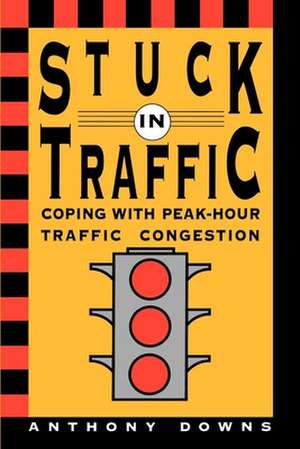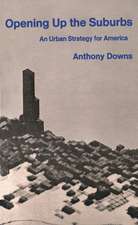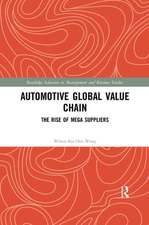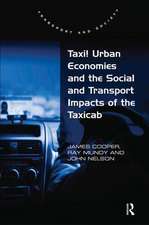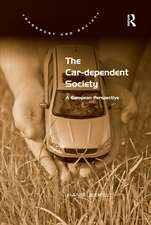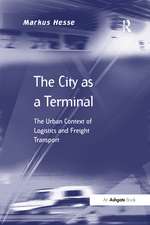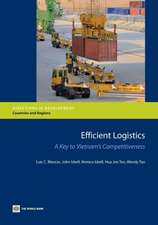Stuck in Traffic: Coping with Peak-Hour Traffic Congestion
Autor Anthony Downsen Limba Engleză Paperback – iun 1992
Peak-hour traffic congestion has become a major problem in most U.S. cities. In fact, a majority of residents in metropolitan and suburban areas consider congestion their most serious local problem. As citizens have become increasingly frustrated by repeated traffic delays that cost them money and waste time, congestion has become an important factor affecting local government policies in many parts of the nation.
In this new book, Anthony Downs looks at the causes of worsening traffic congestion, especially in suburban areas, and considers the possible remedies. He analyzes the specific advantages and disadvantages of every major strategy that has been proposed to reduce congestion. In nontechnical language, he focuses on two central issues: the relationships between land-use and traffic flow in rapidly growing areas, and whether local policies can effectively reduce congestion or if more regional approaches are necessary.
In rapidly growing parts of the country, congestion is worse than it was five or ten years ago. But Downs notes that the problem has apparently not yet become bad enough to stimulate effective responses. Neither government officials nor citizens seem willing to consider changing the behavior and public policies that cause congestion. To alleviate the problem, both groups must be prepared to make these fundamental changes. Selected by Choice as an Outstanding Book of 1992 Co-published with the Lincoln Institute of Land Policy
In this new book, Anthony Downs looks at the causes of worsening traffic congestion, especially in suburban areas, and considers the possible remedies. He analyzes the specific advantages and disadvantages of every major strategy that has been proposed to reduce congestion. In nontechnical language, he focuses on two central issues: the relationships between land-use and traffic flow in rapidly growing areas, and whether local policies can effectively reduce congestion or if more regional approaches are necessary.
In rapidly growing parts of the country, congestion is worse than it was five or ten years ago. But Downs notes that the problem has apparently not yet become bad enough to stimulate effective responses. Neither government officials nor citizens seem willing to consider changing the behavior and public policies that cause congestion. To alleviate the problem, both groups must be prepared to make these fundamental changes. Selected by Choice as an Outstanding Book of 1992 Co-published with the Lincoln Institute of Land Policy
Preț: 228.80 lei
Nou
Puncte Express: 343
Preț estimativ în valută:
43.78€ • 45.83$ • 36.23£
43.78€ • 45.83$ • 36.23£
Carte tipărită la comandă
Livrare economică 05-19 aprilie
Preluare comenzi: 021 569.72.76
Specificații
ISBN-13: 9780815719236
ISBN-10: 081571923X
Pagini: 224
Ilustrații: Illustrations
Dimensiuni: 152 x 229 x 7 mm
Greutate: 0.35 kg
Ediția:New.
Editura: Brookings Institution Press
Colecția Brookings Institution Press
ISBN-10: 081571923X
Pagini: 224
Ilustrații: Illustrations
Dimensiuni: 152 x 229 x 7 mm
Greutate: 0.35 kg
Ediția:New.
Editura: Brookings Institution Press
Colecția Brookings Institution Press
Notă biografică
Anthony Downs is a senior fellow in the Economic Studies Program at the Brookings Institution. His specialties are housing, real estate, real estate finance, metropolitan planning, demographics, and transportation. His books include New Visions for Metropolitan America (Brookings/Lincoln Institute for Land Policy, 1994), and Still Stuck in Traffic: Coping with Peak-Hour Traffic Congestion (Brookings, 2004).
Descriere
A Brookings Institution Press and Lincoln Institute of Land Policy publication
Peak-hour traffic congestion has become a major problem in most U.S. cities. In fact, a majority of residents in metropolitan and suburban areas consider congestion their most serious local problem. As citizens have become increasingly frustrated by repeated traffic delays that cost them money and waste time, congestion has become an important factor affecting local government policies in many parts of the nation.
In this new book, Anthony Downs looks at the causes of worsening traffic congestion, especially in suburban areas, and considers the possible remedies. He analyzes the specific advantages and disadvantages of every major strategy that has been proposed to reduce congestion. In nontechnical language, he focuses on two central issues: the relationships between land-use and traffic flow in rapidly growing areas, and whether local policies can effectively reduce congestion or if more regional approaches are necessary.
In rapidly growing parts of the country, congestion is worse than it was five or ten years ago. But Downs notes that the problem has apparently not yet become bad enough to stimulate effective responses. Neither government officials nor citizens seem willing to consider changing the behavior and public policies that cause congestion. To alleviate the problem, both groups must be prepared to make these fundamental changes.
Selected by Choice as an Outstanding Book of 1992
Peak-hour traffic congestion has become a major problem in most U.S. cities. In fact, a majority of residents in metropolitan and suburban areas consider congestion their most serious local problem. As citizens have become increasingly frustrated by repeated traffic delays that cost them money and waste time, congestion has become an important factor affecting local government policies in many parts of the nation.
In this new book, Anthony Downs looks at the causes of worsening traffic congestion, especially in suburban areas, and considers the possible remedies. He analyzes the specific advantages and disadvantages of every major strategy that has been proposed to reduce congestion. In nontechnical language, he focuses on two central issues: the relationships between land-use and traffic flow in rapidly growing areas, and whether local policies can effectively reduce congestion or if more regional approaches are necessary.
In rapidly growing parts of the country, congestion is worse than it was five or ten years ago. But Downs notes that the problem has apparently not yet become bad enough to stimulate effective responses. Neither government officials nor citizens seem willing to consider changing the behavior and public policies that cause congestion. To alleviate the problem, both groups must be prepared to make these fundamental changes.
Selected by Choice as an Outstanding Book of 1992
